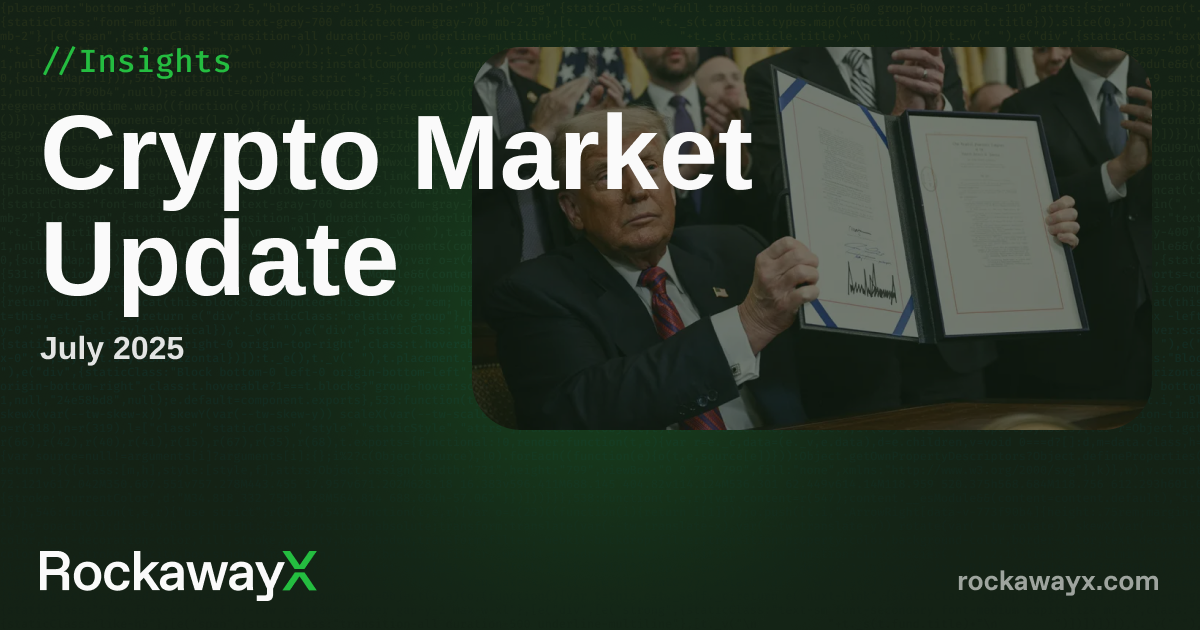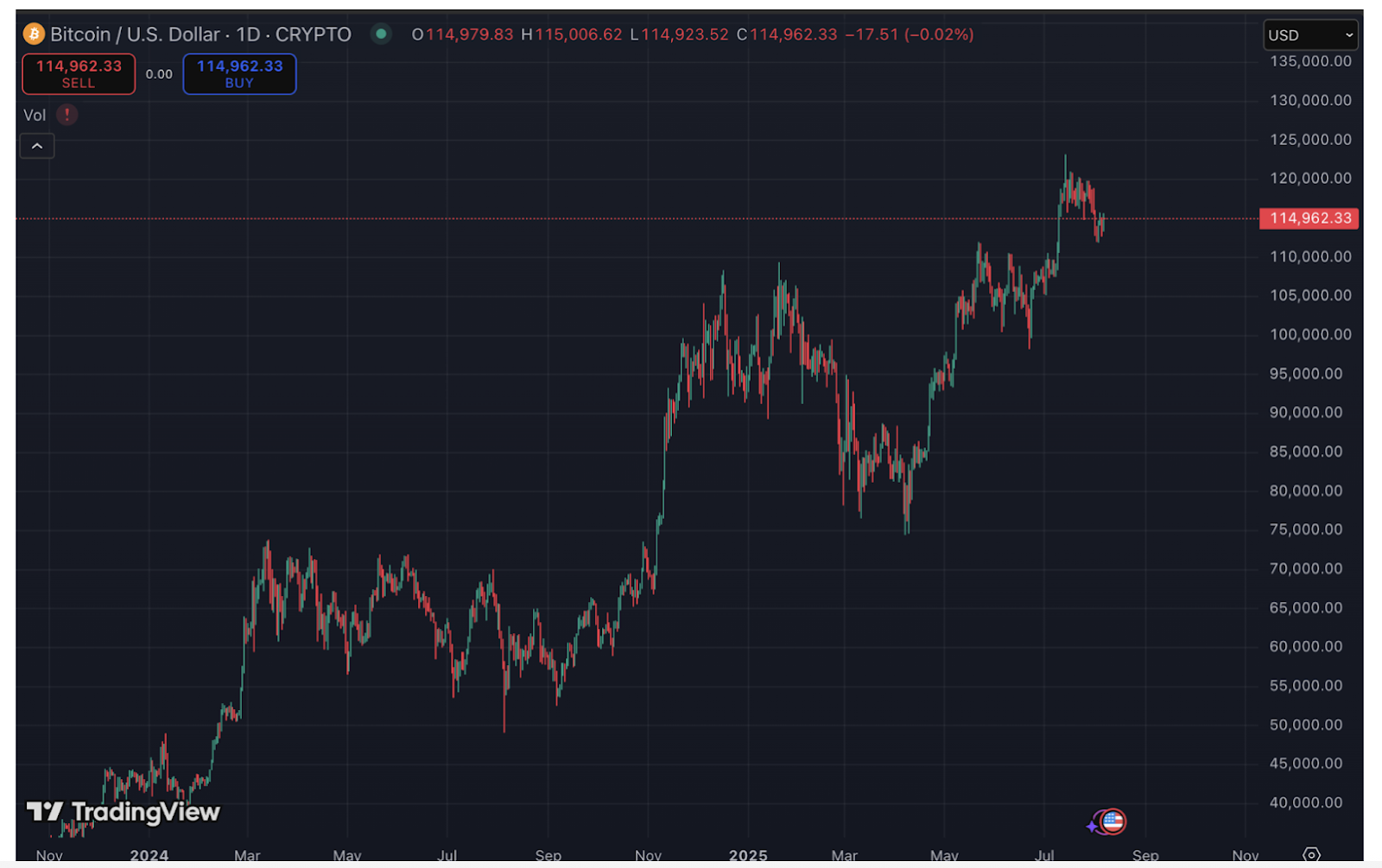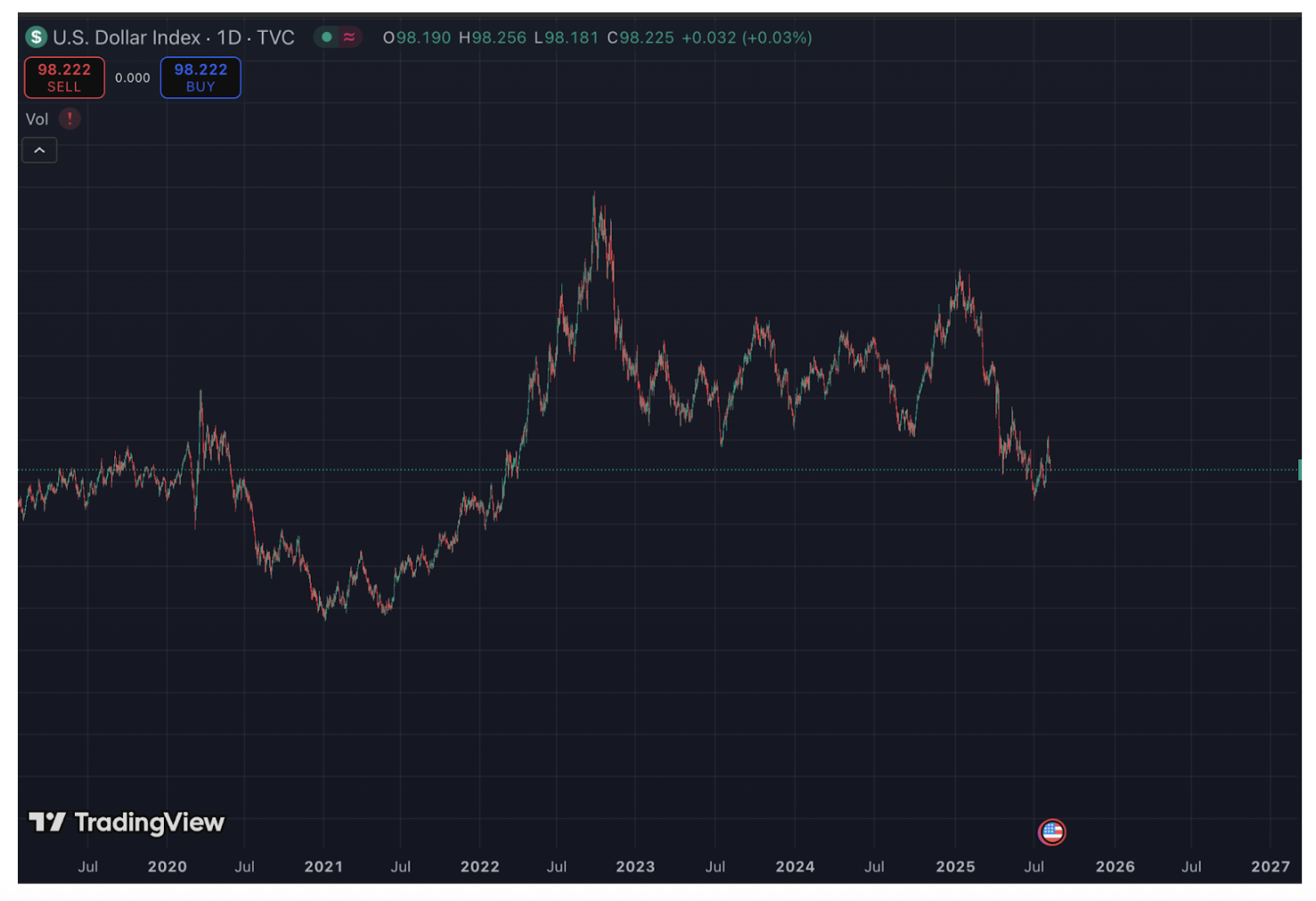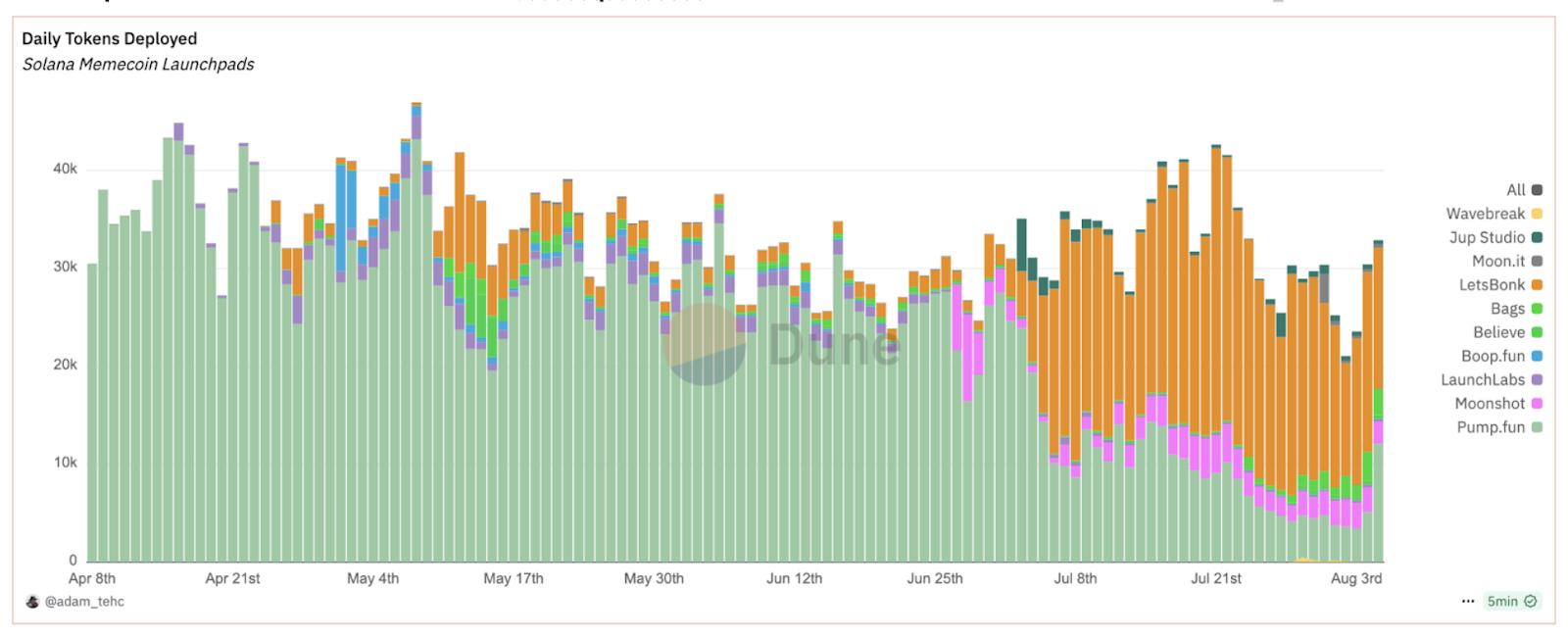
July Summary
- Macro Backdrop: A weakening DXY and the expectation of the Federal Reserve's 50-75bp rate cuts have created a supportive environment for risk assets, confirming our thesis from earlier this year.
- Price Action Highlights: Bitcoin has spent the month consolidating its gains around the ~$110K - $120K level, making a new all-time high (ATH) at ~$123K. ETH moved up +60% over July, stopping just shy of $4K, and continues its run in August.
- TradFi Listings: As institutions want crypto exposure through TradFi, we are seeing a race to market for Digital Asset Treasury (DAT) companies and crypto equities, though at this point, some DATs trade at a discount to NAV.
- Regulatory Breakthrough: The passing of the GENIUS and CLARITY Acts has provided the US digital asset industry with a clear regulatory framework, marking a critical moment for institutional adoption.
- Key Upcoming Events: Discussions around a spot Solana (SOL) ETF are underway, and we expect large inflows into it.
July Review: A Favourable Macro & Summer Chop
As we predicted in our June report, BTC broke out and established a new ATH. The past month has been characterised by a breakout to ATH of ~$123K followed by healthy consolidation in a relatively tight range between $110K and $120K.

Underpinning this market stability is an increasingly favourable macro environment. As forecasted in Q1, the administration’s trade policies have guided the US Dollar Index (DXY) lower. The index has decisively retested the key 100 level and broken below it as the market anticipates a resolution to the tariff negotiations, increasing global liquidity.
Furthermore, the futures markets are expected to deliver at least a 50 bps rate cut in H2 as US inflation is relatively steady for the month prior at 2.7% over June.

This combination of a weaker dollar and expected falling interest rates creates a powerful tailwind for risk assets and inflation hedges like Gold and Bitcoin.
Policy That Matters
Congress just passed the most important acts on digital assets to date. They are:
- GENIUS Act – Signed by President Trump on 18 July 2025. It forces full cash and short‑term Treasury backing for stablecoins and mandates monthly reserve disclosures.
- CLARITY Act – Cleared the House 294‑134 on 17 July and now awaits Senate Banking Committee markup. It splits the stack into digital commodities (CFTC) and digital securities (SEC), lets tokens “mature” out of securities status via decentralisation tests.
In a speech, the new SEC Chair Paul S. Atkins announced “Project Crypto,” a commission-wide effort to change custody, trading and disclosure rules so that U.S. markets can “move on‑chain.” This fits with the Internet Capital Markets (ICM) narrative that Solana has of real world assets moving on-chain; this is the catalyst that drives crypto fundamentals such as total value locked and user base significantly higher, raising digital asset prices with it.
We believe Solana will be the venue for the ICM narrative as they are positioned to win in the high-bandwidth, low-latency L1 race.
Our Take: A Choppy Summer with Thin Liquidity, Then Bull Q4
The key theme we discussed in June, the performance disparity between institutional equities and native altcoins, has evolved, with some equities cooling off and pulling back from their speculative valuations. We also cover the ICO of $PUMP, the leading memecoin launchpad on Solana, and the Jito BAM upgrade.
Crypto Stocks & ICOs Find Gravity
The initial bullishness for all crypto-related public stocks is cooling, Circle (CRCL) has pulled back from its ~$300 peak to the ~$150 level, it still trades at a hefty ~209 PE multiple. Coinbase (COIN) also pulled back from ~$445 to ~$300; only Robinhood (HOOD) remains close to all-time highs with minimal pull backs.
In tokens, the post-ICO performance of Pump.fun ($PUMP) was underwhelming. Pump.fun is a memecoin launchpad on Solana which allows users to launch their own tokens. They raised $1.3B in an ICO raise and made ~$700m of fees in a year. With an ICO valuation of $4B, the token now trades at $3.4B after finding a bottom, for now, at $2.4B, close to the “book value” of $2B based on fee revenue and the ICO raise. We believe that the token may have bottomed now; our on-chain analytics show that the public ICO participants have sold (or transferred) 95% of their tokens and 46% of funds have sold (or transferred) their tokens.

We assume those that want out, are out, and those that still hold it are in it for the long haul. As the price returns to the ICO price, it would be interesting to see how price action behaves since funds that were underwater return to breakeven.
The driving factors for this were several:
- The Pump ICO raised a larger amount from funds than expected, so marginal buyers were scarce.
- LetsBonk, another meme coin launchpad, had taken the majority of market share and is perceived as “community aligned” with a public $BONK buy and burn mechanism and a buyback mechanism for launched tokens as well.
- The Pump team is learning to adapt to the change in market structure and has begun to communicate more about their roadmap and publicly share data on fees and buybacks through official channels (https://fees.pump.fun/).
This increase in transparency and likelihood of fewer remaining marginal sellers may be why price action for $PUMP in the beginning of August has been more bullish and there seems to be positive momentum with Pump.fun’s market share back to above 70%.

Jito's BAM Upgrade
Jito ($JTO) is both a liquid staking service, where users earn staking rewards on your SOL while still being able to use it elsewhere, and an MEV network, which captures extra value from the way transactions are ordered within a block on Solana. It powers ~87% share of Solana’s block production and transaction flow. The JTO token gives holders a say in how Jito is run, making it a bet on both the staking business and its control of Solana’s transaction layer. The team has announced its new Block-space Auction Mechanism (BAM). While the tech is an upgrade, there is an additional benefit; Jito will capture close to 100% of Solana’s transaction flow. In addition to this, a forthcoming Jito Improvement Proposal (JIP) will direct all of the protocol fees from both BAM and the existing Jito Block Engine directly to the Jito DAO Treasury.
This shift establishes a direct, powerful link between network activity and value accrual for $JTO holders, who control the DAO. As Solana grows and Jito’s infrastructure captures more value, that value now flows directly to token holders. These changes will be formally proposed in a JIP in the coming weeks and are subject to approval by Jito DAO governance.
We believe this is bullish for $JTO holders and we are positioned accordingly.
Market Catalyst: Solana ETF and Other Upcoming Catalysts
Institutional adoption and capital inflows remain the dominant driver of the current crypto bull market, fuelled by both the launch of spot Bitcoin and Ethereum ETFs and a growing cohort of treasury‐strategy companies following MicroStrategy’s lead. The dynamic is evident in Ethereum’s recent outperformance, where ETH treasury acquisitions have provided a visible bid for the token.
A parallel catalyst on the horizon is the rollout of Solana ETFs, which will give institutions a low-cost, operationally simple channel to gain SOL exposure. The first US-listed product—the REX-Osprey Solana + Staking ETF (ticker: SSK)—debuted on CBOE BZX on 2 July 2025. While initial flows have been modest, the marquee issuers are still in the queue: Franklin Templeton, Grayscale, Fidelity, Invesco, Bitwise, VanEck, and 21Shares have all filed for Solana vehicles. We anticipate approvals in short order, setting the stage for a meaningful demand uplift.
A noteworthy distinction among the pending filings is that several—including those from Fidelity and VanEck—expressly permit staking. By delegating SOL and distributing the resulting staking rewards to shareholders, these funds could offer an incremental yield that should resonate with income-oriented allocators and further enhance Solana’s institutional appeal.
Conclusion
In summary, a softer dollar and imminent Fed easing have reinforced the bid for crypto-risk, while Bitcoin’s orderly consolidation near new highs and Ethereum’s sharp rally underscore solid underlying demand. Traditional-finance channels are racing to package that demand—whether through digital-asset treasury vehicles or pending equity listings—even as some DATs now trade below NAV.
With the GENIUS and CLARITY Act supplying long-sought regulatory certainty and a spot Solana ETF likely on deck, the stage is set for a fresh wave of institutional inflows.